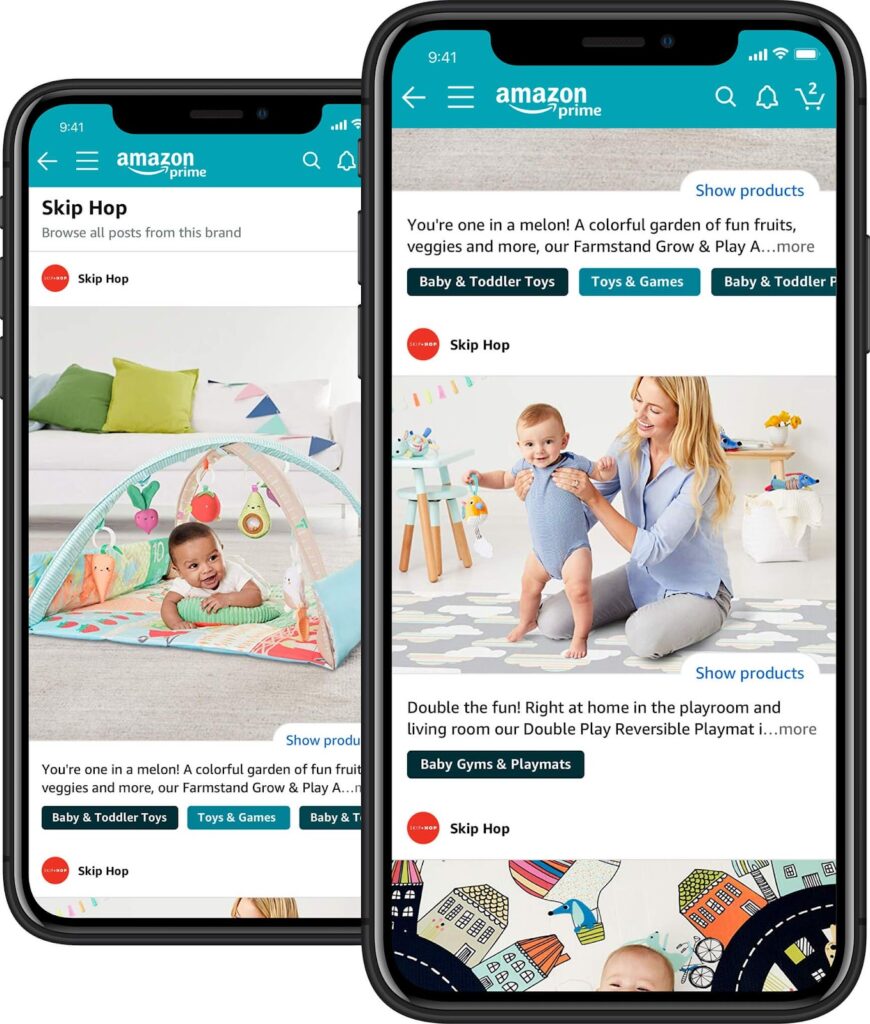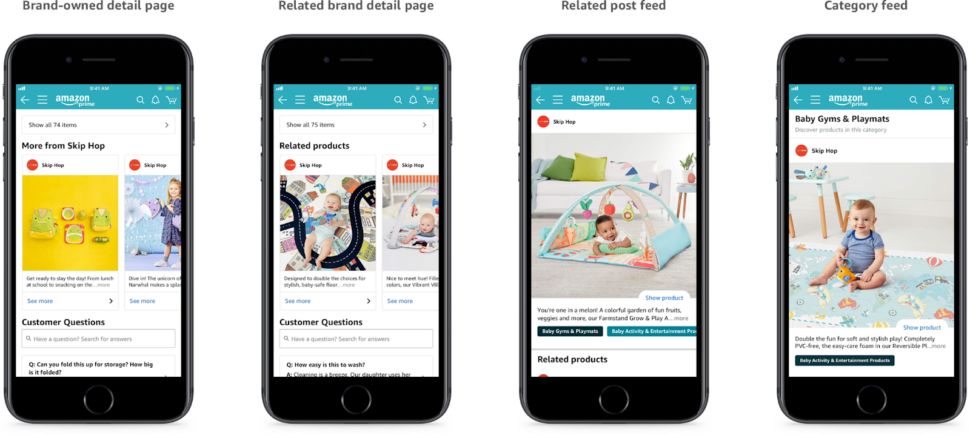Amazon Posts is similar to a social media feed. It enables online retailers to promote their brand and products directly in Amazon. Sellers provide the content that best showcases their products, and Amazon displays those Posts where shoppers want to see them most.
Posts is a great tool for advertising and brand awareness, but a lot of sellers stay away from it because, well, they don’t know how it works or how to use it!
In this article, we’ll answer all your questions about Amazon Posts so that you can take advantage of this tool to get more sales.
Table of contents
- What is Amazon Posts?
- Who can use Amazon Posts?
- Where is Amazon Posts currently available?
- Where will my Amazon Posts appear?
- How do I choose where my Posts will be displayed?
- What are the 5 elements of an Amazon Post?
- Pros and cons of Amazon Posts
- Where can I measure my Posts’ performance?
- How do I sign up for Amazon Posts?
- How can I be successful with my Amazon Posts?
What is Amazon Posts?
Let’s start with the basics. Amazon Posts is an advertising tool by Amazon that displays social-media-esque cards on relevant pages throughout the Amazon marketplace.
It’s been around since 2019 and is currently in beta.
The posts themselves often feature appealing product photos or lifestyle images of products in use, along with a caption and a direct link to the product page for quick purchasing.
Unlike advertising with Amazon PPC ads, it’s free to create and upload Posts. In fact, there’s no limit to how many Posts you create or how often you upload them, so there’s no real downside to using them.
Who can use Amazon Posts?
Because it’s still in development, Amazon Posts is not yet accessible to everyone. To use it, you must be:
- selling in the U.S.
- registered with the Amazon Brand Registry
Amazon demand-side platform (DSP) customers can also create Posts as long as they have an advertising console account on top of their Amazon DSP account.
Where is Amazon Posts currently available?
At the moment, Amazon Posts is only available in the United States. As the system is still in beta, we can only assume it’ll expand to other markets in the future.
Where will my Amazon Posts appear?
Amazon Posts appear in a variety of locations throughout the Amazon marketplace.
Although Amazon might add more places in the future, at the moment Posts can appear in four areas:
- Your brand’s feed
- Your product’s detail page
- Related products’ detail page
- Category feed
Your brand feed is like your own mini-feed that lists all your Posts, similar to a social media wall.
On your product pages and those of your competitors, your Posts will appear as part of an interactive, clickable carousel.
As for the category feed, Amazon assigns auto-tags to your Posts based on the product category. Clicking on those tags brings up all related Posts for that category.
How do I choose where my Posts will be displayed?
Unfortunately, you don’t control where your Posts appear. Amazon does.
Amazon’s algorithm selects where your Amazon Posts show up based on relevance and customer engagement. That means the more people like your product, the more its related Posts will pop up.
By effectively managing customer feedback on Amazon, you can improve your product, keep the positive customer reviews coming, and help your Posts gain visibility.
What are the 5 elements of an Amazon Post?
Each Post has five essential parts:
- Your brand name and logo. This appears at the top of your Post just like a social media username, along with a small image of your logo.
- Image. The visual content that makes up most of your Post.
- Show product tab. Viewers click on this to reveal a mini-card for your product with its full title, rating, and price; clicking on the mini-card takes the user straight to the product page.
- Caption. Amazon allows up to 2,200 characters to pitch your product however you’d like. However, the Post only shows the first two lines by default.
- Tags. Amazon automatically adds relevant category tags based on the type of product you’re advertising.
Pros and cons of Amazon Posts
Amazon Posts can be a mixed bag, depending on what you’re selling and your brand’s sales strategies.
Here are some pros and cons to help you decide if Posts is right for you.
Pros of Amazon Posts
- It’s free
- It sets you apart from your competitors’ product pages
- Customers can “follow” your brand for stronger loyalty
- You can collect engagement data to better understand your shoppers
- You can repurpose social media content
Cons of Amazon Posts
- You don’t choose where Posts appear
- Competitors can use it to steal shoppers from your pages
- It’s only available for the U.S. market
Where can I measure my Posts’ performance?
One of the advantages of Amazon Posts is the data it provides — not just about your Posts, but also about the types of shoppers who interact with them.
You can see this data directly in your dashboard when you sign in at posts.amazon.com.
How do I sign up for Amazon Posts?
Signing up for Amazon Posts is easy as long as you meet the requirements we listed above (such as registering with the Amazon Brand Registry).
Simply go to posts.amazon.com and sign in with the username connected to your Amazon advertising.
You’ll need to verify your brand name, fill in your profile, and upload an image of your logo.
How can I be successful with my Amazon Posts?
Want to use Amazon Posts to the fullest? Here are some tips to make the most of it.
1. Add new Posts regularly
As with social media, Amazon Posts users benefit from regular posting. Not only does this ensure that your Posts stay fresh and up-to-date, but it also gives your feed plenty of content for followers to peruse.
Because there’s no limit to how many Posts you can put up, it’s OK to do it every day or even multiple times per day. Produce content for as many product categories as you can to enhance your reach and target new types of shoppers.
2. Post enticing images and captions
Another tip from the social media playbook: use attention-grabbing visuals and riveting captions to encourage engagement. Shoppers will ignore bland and unassuming Posts. If you want their clicks, you have to make your Posts stand out with interactive content, such as quizzes.
That goes beyond having nice-looking product photos. Try posting lifestyle photos of your products in everyday use. Shoppers tend to respond to images that feature people, especially faces, so include images of people using and enjoying what you’re selling.
3. Use split testing to see what works
The best way to know whether a Post’s image and caption will resonate with your audience is to test it, ideally before you take it live.
While you can use Amazon split testing to experiment inside the marketplace, the downside is that you’re testing on actual shoppers. It usually takes weeks to run a test and get the data. And if shoppers don’t like your test image, your sales could take a hit.
An alternative is to use an external Amazon A/B testing tool like PickFu. This DIY polling platform enables you to collect quantitative and qualitative data without the risk of losing customers.
PickFu lets you quickly test variations of your Posts or specific images, captions, or copy — any variable you want, really — with a target audience of consumers. Upload screenshots or images, then select respondents according to certain demographics and traits, such as Amazon Prime members. You’ll get results, including written feedback from each respondent, that same day.
PickFu can help with more than just Amazon Posts. Think of it as an Amazon listing optimization tool that takes the guesswork out of knowing what your customers want. Use it to test your product titles, logo, brand name, target SEO keywords, and more.
Have more questions about Amazon Posts or PickFu? Let us know in the comments below.







